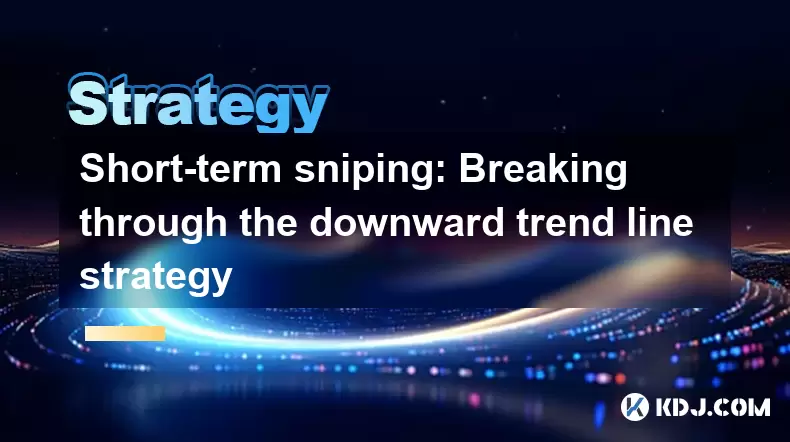-
 bitcoin
bitcoin $122090.672462 USD
1.59% -
 ethereum
ethereum $4493.758974 USD
0.56% -
 xrp
xrp $3.033145 USD
0.65% -
 tether
tether $1.000629 USD
0.00% -
 bnb
bnb $1169.854250 USD
7.07% -
 solana
solana $230.954786 USD
-0.19% -
 usd-coin
usd-coin $0.999785 USD
0.00% -
 dogecoin
dogecoin $0.256108 USD
-1.12% -
 tron
tron $0.342333 USD
-0.12% -
 cardano
cardano $0.859632 USD
-0.10% -
 hyperliquid
hyperliquid $48.932146 USD
-2.25% -
 chainlink
chainlink $22.345466 USD
-1.29% -
 ethena-usde
ethena-usde $1.000217 USD
-0.03% -
 avalanche
avalanche $31.203456 USD
1.93% -
 sui
sui $3.579145 USD
1.05%
Short-term sniping: Breaking through the downward trend line strategy
Short-term sniping in crypto involves quick trades based on breaking through downward trend lines, requiring technical analysis and swift action.
Jun 05, 2025 at 12:28 am

Short-term sniping in the cryptocurrency market involves taking quick, strategic positions to capitalize on short-lived market movements. One popular strategy among traders is breaking through the downward trend line. This approach requires a keen understanding of technical analysis and the ability to act swiftly. In this article, we will delve into the intricacies of this strategy, exploring how to identify, execute, and manage trades based on breaking through a downward trend line.
Understanding Downward Trend Lines
A downward trend line is a technical analysis tool used to identify the direction of a security's price movement. It is drawn by connecting the highs of a price chart, showing a series of lower highs. This indicates that the market is in a bearish phase, with sellers dominating the market. When a price breaks through this line, it can signal a potential reversal or a temporary bullish move.
To identify a downward trend line, traders should look for at least two significant highs that can be connected with a straight line. The more touchpoints the line has, the more reliable it is considered. Once the line is drawn, any price movement that breaks above this line could be a signal for a short-term sniping opportunity.
Setting Up for the Breakthrough
Before executing a trade based on a breakthrough of a downward trend line, it's crucial to set up the right conditions. This involves selecting the appropriate time frame and ensuring that the trend line is valid and not just a random fluctuation.
- Choose the right time frame: Depending on your trading style, you might opt for shorter time frames like 15-minute or 1-hour charts for more frequent opportunities, or longer time frames like 4-hour or daily charts for more significant moves.
- Validate the trend line: Ensure that the trend line you draw has at least two significant touchpoints and that it aligns with the overall market sentiment. A trend line that is too steep or too shallow may not be reliable.
- Confirm with other indicators: Use additional technical indicators like the Relative Strength Index (RSI) or Moving Averages to confirm the potential breakout. A bullish divergence on the RSI or a price moving above a key moving average can add confidence to the setup.
Executing the Trade
Once you have identified a potential breakthrough, it's time to execute the trade. This involves setting entry points, stop-losses, and take-profit levels to manage risk and maximize potential gains.
- Entry point: The ideal entry point is when the price convincingly breaks above the downward trend line. This can be confirmed with a candlestick closing above the line or a significant volume spike accompanying the breakout.
- Stop-loss: Place the stop-loss just below the most recent low before the breakout. This protects you from a false breakout and limits your potential loss.
- Take-profit: Set the take-profit level based on the next significant resistance level or a predetermined risk-reward ratio. A common approach is to aim for a 2:1 or 3:1 reward-to-risk ratio.
Managing the Trade
After entering the trade, active management is essential to adapt to changing market conditions. This involves monitoring the trade and making adjustments to stop-loss and take-profit levels as the price moves in your favor.
- Trail the stop-loss: As the price moves higher, trail your stop-loss to lock in profits and protect against a reversal. A common method is to move the stop-loss to just below the most recent swing low.
- Adjust take-profit: If the price continues to move in your favor, consider adjusting the take-profit level to capture more of the move. However, be cautious not to get greedy and miss out on a significant profit.
- Exit strategy: Have a clear exit strategy in place, whether it's hitting your take-profit level, getting stopped out, or manually closing the trade based on new market developments.
Analyzing the Breakthrough
After the trade is closed, it's important to analyze the outcome to improve future trades. This involves reviewing the entry, exit, and overall market conditions to identify what worked and what didn't.
- Review the entry: Did the price convincingly break above the downward trend line? Were the additional indicators supportive of the breakout?
- Assess the exit: Did you exit at the right time? Was the take-profit level too conservative or too aggressive?
- Evaluate market conditions: Were there any external factors that influenced the trade, such as news events or overall market sentiment?
Common Pitfalls and How to Avoid Them
While the strategy of breaking through a downward trend line can be profitable, there are common pitfalls that traders should be aware of and avoid.
- False breakouts: Not every break above a trend line is a genuine reversal. False breakouts can lead to losses if not managed properly. Always use a stop-loss and be prepared to exit quickly if the price fails to sustain above the trend line.
- Overtrading: The allure of short-term sniping can lead to overtrading, which can increase transaction costs and reduce overall profitability. Be selective with your trades and focus on high-probability setups.
- Ignoring market context: A breakthrough might look promising on a smaller time frame but could be part of a larger bearish trend. Always consider the broader market context before entering a trade.
Frequently Asked Questions
Q: How can I improve my accuracy in identifying valid downward trend lines?A: Improving accuracy in identifying valid downward trend lines involves practicing and refining your technical analysis skills. Use multiple time frames to confirm the trend, and look for additional indicators like volume and momentum to validate the trend line. Regularly reviewing past charts and analyzing successful and failed trades can also enhance your ability to spot reliable trend lines.
Q: What are the best time frames for short-term sniping using the downward trend line strategy?A: The best time frames for short-term sniping using the downward trend line strategy depend on your trading style and risk tolerance. For very short-term trades, 5-minute to 15-minute charts can provide frequent opportunities, while 1-hour to 4-hour charts might be more suitable for slightly longer-term trades. Daily charts can be used for significant moves but require more patience.
Q: How important is volume in confirming a breakthrough of a downward trend line?A: Volume is crucial in confirming a breakthrough of a downward trend line. A significant increase in volume during the breakout suggests strong buying interest and adds credibility to the move. A breakout on low volume might be a false signal, so always consider volume when evaluating the strength of a breakthrough.
Q: Can this strategy be applied to all cryptocurrencies, or are there specific ones that work better?A: The strategy of breaking through a downward trend line can be applied to most cryptocurrencies, but it tends to work better with more liquid and widely traded assets. High liquidity reduces the risk of slippage and ensures that the price action is more reliable. Therefore, major cryptocurrencies like Bitcoin and Ethereum might be more suitable for this strategy than less liquid altcoins.
Disclaimer:info@kdj.com
The information provided is not trading advice. kdj.com does not assume any responsibility for any investments made based on the information provided in this article. Cryptocurrencies are highly volatile and it is highly recommended that you invest with caution after thorough research!
If you believe that the content used on this website infringes your copyright, please contact us immediately (info@kdj.com) and we will delete it promptly.
- BlockDAG, DOGE, HYPE Sponsorship: Crypto Trends Shaping 2025
- 2025-10-01 00:25:13
- Deutsche Börse and Circle: A StableCoin Adoption Powerhouse in Europe
- 2025-10-01 00:25:13
- BlockDAG's Presale Buzz: Is It the Crypto to Watch in October 2025?
- 2025-10-01 00:30:13
- Bitcoin, Crypto, and IQ: When Genius Meets Digital Gold?
- 2025-10-01 00:30:13
- Stablecoins, American Innovation, and Wallet Tokens: The Next Frontier
- 2025-10-01 00:35:12
- NBU, Coins, and Crypto in Ukraine: A New Yorker's Take
- 2025-10-01 00:45:14
Related knowledge

Practical parameter settings for a Bitcoin multi-timeframe moving average system
Sep 18,2025 at 10:54pm
Optimizing Timeframe Combinations for Bitcoin Trading1. Selecting appropriate timeframes is crucial when building a multi-timeframe moving average sys...

How can I filter out false breakouts in Dogecoin high-frequency trading?
Sep 22,2025 at 01:00am
Understanding False Breakouts in Dogecoin Trading1. A false breakout occurs when Dogecoin's price appears to move beyond a defined support or resistan...

Techniques for identifying tops and bottoms in the Bitcoin on-chain NVT model
Sep 20,2025 at 07:54pm
Understanding the NVT Model in Bitcoin Analysis1. The Network Value to Transactions (NVT) ratio is often described as the 'P/E ratio' of the cryptocur...

What does the surge in open interest in Bitcoincoin futures mean?
Sep 20,2025 at 11:18pm
Understanding the Surge in Dogecoin Futures Open Interest1. A surge in open interest within Dogecoin futures indicates a growing number of active cont...

How can I use the Ethereum USDT premium to gauge market sentiment?
Sep 18,2025 at 11:55pm
Understanding the Ethereum USDT Premium1. The Ethereum USDT premium refers to the price difference between USDT (Tether) traded on Ethereum-based plat...

What should I do if Ethereum staking yields decline?
Sep 20,2025 at 06:18am
Understanding the Causes Behind Declining Ethereum Staking Yields1. The Ethereum network transitioned to a proof-of-stake consensus mechanism with the...

Practical parameter settings for a Bitcoin multi-timeframe moving average system
Sep 18,2025 at 10:54pm
Optimizing Timeframe Combinations for Bitcoin Trading1. Selecting appropriate timeframes is crucial when building a multi-timeframe moving average sys...

How can I filter out false breakouts in Dogecoin high-frequency trading?
Sep 22,2025 at 01:00am
Understanding False Breakouts in Dogecoin Trading1. A false breakout occurs when Dogecoin's price appears to move beyond a defined support or resistan...

Techniques for identifying tops and bottoms in the Bitcoin on-chain NVT model
Sep 20,2025 at 07:54pm
Understanding the NVT Model in Bitcoin Analysis1. The Network Value to Transactions (NVT) ratio is often described as the 'P/E ratio' of the cryptocur...

What does the surge in open interest in Bitcoincoin futures mean?
Sep 20,2025 at 11:18pm
Understanding the Surge in Dogecoin Futures Open Interest1. A surge in open interest within Dogecoin futures indicates a growing number of active cont...

How can I use the Ethereum USDT premium to gauge market sentiment?
Sep 18,2025 at 11:55pm
Understanding the Ethereum USDT Premium1. The Ethereum USDT premium refers to the price difference between USDT (Tether) traded on Ethereum-based plat...

What should I do if Ethereum staking yields decline?
Sep 20,2025 at 06:18am
Understanding the Causes Behind Declining Ethereum Staking Yields1. The Ethereum network transitioned to a proof-of-stake consensus mechanism with the...
See all articles










































































